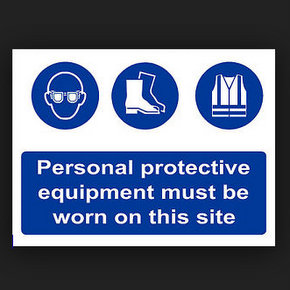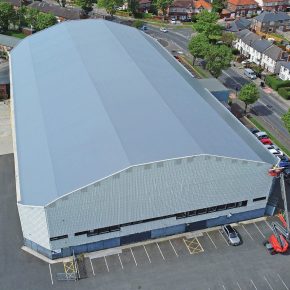
Understanding when to use Personal Protective Equipment (PPE)
 GUEST BLOG: Hannah Spruce looks at what you need to know about PPE, including selecting the right equipment and knowing how to use it. Hannah writes for High Speed Training, an online training provider that offers a wide range of health and safety eLearning courses.
GUEST BLOG: Hannah Spruce looks at what you need to know about PPE, including selecting the right equipment and knowing how to use it. Hannah writes for High Speed Training, an online training provider that offers a wide range of health and safety eLearning courses.
Personal Protective Equipment (PPE)
If your work poses a hazard to you, your employer should have done a risk assessment to reduce those hazards. You might need PPE; you might not.
Think of risk reduction as a scale, with group measures coming first, and PPE as the last measure on that scale.
Group risk reduction comes first because they’re in place to reduce risks for everyone and have the greatest potential to reduce risks.
PPE? That’s the extra cushioning to protect you – the individual – if the worst does happen, or when hazards are unavoidable. But, it only comes out when all other bases are covered; when the scaffolding is up, when the airbags are in place, then that’s when the hard hats come out.
This guide is a brief breakdown of what you need to know about PPE, selecting it and using it.
Know the limitations of PPE
Over Christmas, my brother and I came back to my parents home (hang on, this is relevant). One evening, he used heat resistant gloves to open the stove and add more logs.
But, thinking the gloves were fire-retardant, he decided to rearrange the burning logs.
He came away with the tips of the gloves lightly on fire, and after a moment of flapping he was left with the tips charred.
So, my parent’s got what they always wanted, a pair of DIY fingerless heat protective gloves. Very useful.
But, there’s a valuable lesson to be learnt here: know the limitations of the PPE you use.
That, and, PPE will not make you fireproof, especially if it doesn’t claim to be fireproof on the tin. Note: read the tin. And, get proper training and instruction on how to use your PPE.
- Always use PPE as it is advised and don’t neglect to use it, even if you’re exposed to a hazard for just a few minutes.
- It’s up to employers to pay for PPE and to provide correct instruction on how to use PPE.
When should I be using PPE?
Whenever your work poses a hazard to you, PPE will reduce those risks.
PPE minimises potential risks to your lungs, head, eyes, skin, and body from external harm.
To help you decide what PPE you need to use, imagine the work you’ll be doing and ask yourself:
- What are the hazards that this work will expose me to?
- How long am I exposed to these hazards?
- How much of a hazard does the work pose?
Answering these questions helps you think through what you’ll need to complete your work safely, protecting your body, face and lungs from harm.
Picking your PPE
- Choose CE marked products (or ask the supplier if they are made to the standards of Personal Protective Equipment Regulations 2002).
- Choose PPE that suits you; get the right fit, size, and weight.
- If you need multiple items, make sure that each item doesn’t interfere with another and prevent it from working properly.
And that’s it, you’re good to go.
Latest news

22nd April 2024
New EJOT role will develop strategic support for UK flat roofing sector
EJOT UK has taken a major step in the expansion of its support for the flat roofing market by appointing one of its most experienced building envelope fastening specialists as its first sector-dedicated business development manager.
Posted in Articles, Building Industry News, Building Products & Structures, Building Systems, Innovations & New Products, Posts, Recruitment, Restoration & Refurbishment, Retrofit & Renovation, Roofs
22nd April 2024
Access2 Wins ADSA-Sponsored Award at AI Specification Awards
Access2 clinched the ADSA-sponsored Product Design and Innovation Award (Electronic) at the AI Specification Awards 2024 on Thursday.
Posted in Access Control & Door Entry Systems, Architectural Ironmongery, Articles, Awards, Building Associations & Institutes, Building Industry Events, Building Industry News, Building Products & Structures, Building Services, Doors, Facility Management & Building Services, Information Technology, Innovations & New Products, Retrofit & Renovation, Security and Fire Protection, Video of the Week
19th April 2024
ASSA ABLOY: Access solutions can impact sustainability performance across the full life-cycle of a building
Embedding sustainability within any organisation requires a broad, strategic perspective. Scrutiny should include the physical infrastructure itself: According to the IEA, buildings consume around 30% of global energy*. ASSA ABLOY has more…
Posted in Access Control & Door Entry Systems, Architectural Ironmongery, Articles, Building Industry News, Building Products & Structures, Building Regulations & Accreditations, Building Services, Case Studies, Doors, Facility Management & Building Services, Information Technology, Research & Materials Testing, Retrofit & Renovation, Security and Fire Protection, Sustainability & Energy Efficiency, Video of the Week
19th April 2024
British weather doesn't dampen spirit for new HMG Garden Paint
Despite one of the wettest starts to the year on record, customers are starting to plan for brighter days with HydroPro Garden Paint from HMG Paints.
Posted in Articles, Building Industry News, Building Products & Structures, Garden, Innovations & New Products, Paints, Paints, Coatings & Finishes, Restoration & Refurbishment, Retrofit & Renovation, Site Preparation, Sustainability & Energy Efficiency, Waste Management & Recycling
 Sign up:
Sign up: